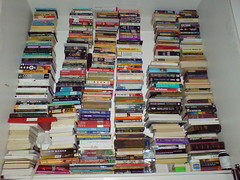 |
| "Books behind the bed," Creative Commons from zimpenfish |
Burton, Gideon. "Ecphrasis." Silva Rhetoricae. Brigham Young U, n.d. Web [an academic blog showing a disciplined focus on topics] A scholarly article I mention below is about ecphrasis and the rhetoric website gives a good set of definitions of it. If I want to base part of my argument on the idea of Hermione's statue as a self-conscious ekphrastic move, it would be good to define for readers: "Vivid description; using details to place an object, person, or event before the listeners' eyes."
Dunlap, Amelia. A Winter's Fairy Tale. Brigham Young University. Nelke Theater, Provo, UT. 21 March 2013. [a very current source] I went to see this adaptation because Mikaela and Liz had mentioned it. The director chose to focus on story of Perdita, spending only a few minutes on setting up the story of Leontes and Hermione. The choice of the title, A Winter's Fairy Tale, suggests that in this interpretation of the play, Hermione really is dead and comes back to life and the play is full of magic, not as closely tied to real life.
Kermode, Frank. Afterword. The Winter's Tale. By William Shakespeare. Ed. Frank Kermode. New York: Signet Classic, 1988. Print. [a source found within a scholarly edition of the primary text] This gives a summary and analysis of Pandosto, a tragic novella written by Robert Greene and the story that Shakespeare based his play on. I think Shakespeare's addition of the magical statue of Hermione is important as he changed Greene's tragic play to a happy, magical romance by adding an unbelievable element. I want to know more about Shakespeare's motives, if they were purely for entertainment value, or otherwise.
Meek, Richard. "Ekphrasis in The Rape of Lucrece and The Winter's Tale." Studies in English Literature 1500-1900 46:2, Spring 2006:389-414. Web. [a scholarly article, within the last ten years] This article has added a lot to my argument and I have used it in my outline for the paper. Meek argues that the statue of Hermione is a metaphor for the play, both of them coming alive through vivid description, as this is what ekphrasis refers to. I feel like this makes both the play and the statue very real, most of my argument.
Romano, Giulio. Isabella d'Este. Royal Collection, London. Oxford Art Online. 26 Mar. 2013. [A source recommended by an enthusiast I've discussed my project with, 10-50 years]. Martin, who I met through goodreads, suggested looking into Julio Romano, who is mentioned in Act 5, scene 2, as the artist that created Hermione's statue. Julio Romano was a real artist and Shakespeare's mentioning his name seems to add validity to Hermione as an actual statue, as a real artist was called in to help create her. It's like Shakespeare is mixing his fictional world with the real world of the audience.
Tatspaugh, Patricia Elizabeth. The Winter's Tale: Shakespeare at Stratford Series. Croatia: Arden Shakespeare, 2002. Web. [e-book, 10-50 years] I just searched e-books using the link Dr. Burton provided on the assignment description under the Research Overview and this source seems AWESOME. It goes through different adaptations of the play, exploring "how directors, designers and actors have explored the richness of Shakespeare's late romance and how their explorations have realized the compelling nature of the play." This looks like it will be so helpful because the author seems to believe that audiences are really affected by the last scene, even though many have written it off as unrealistic.
Wells, Stanley. "Romance." A Dictionary of Shakespeare. Oxford Reference. Web. [a source found by way of a library research guide] I used this in my rough draft because it gives a brief definition and background to romances, a main claim of my argument. It also mentions common motifs of romances, which will help as I'm discussing how those motifs are applicable to real life.
Young, Bruce. "The Ending of the Winter's Tale." Shaksper. 20.0455. The Global Electronic Shakespeare Conference. Web. 26 Mar. 2013. [a source that comes by way of a social network through a conference] This source is a comment, as part of an online Shakespeare conference, from a professor I had last semester. He claims that we reject the ending of The Winter's Tale because somehow we shy away from happy endings, not a logical reason to reject it. He quotes Woody Allen and says this is a common thread of thought today: "'In real life, people disappoint you. . . . They're cruel, and life is cruel. I think there is no win in life. Reality is a very painful, tough thing that you have to learn to cope with in some way. What we do is escape into fantasy, and it does give us moments of relief." I would argue against this point.
I like how you have directed your bibliography to include more than just scholarly work but also things you have picked up while doing outside research.
ReplyDelete